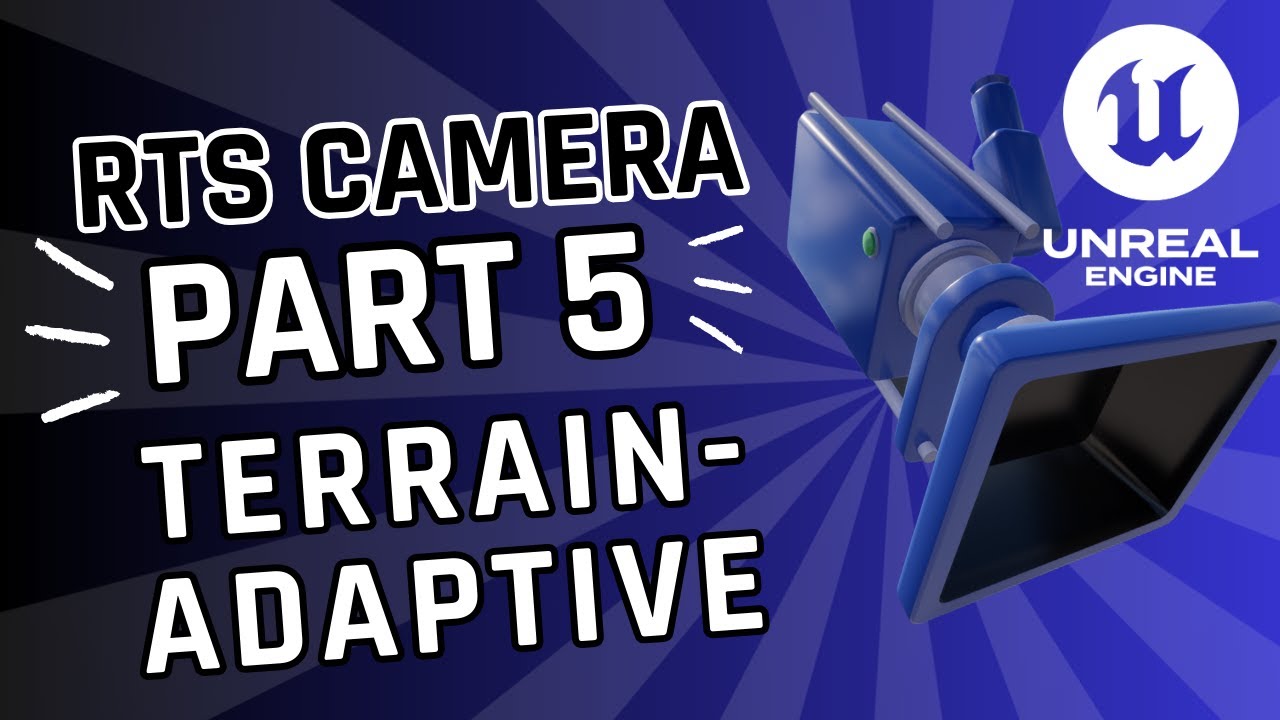
Part 5 – How To Make Your RTS Camera Follow Terrain in Unreal Engine 5!
Add terrain-following to your RTS camera in UE5.6. Build line trace logic, apply offset, and make your camera adapt smoothly to hills, slopes, and cliffs.
This is Rambod, and welcome back to the RTS Camera Series.
So far, we’ve built the project setup, WASD movement, zoom, and rotation. In this part, by request from the community, we’ll add terrain adaptation so the RTS camera smoothly follows hills, slopes, and cliffs.
By the end of this tutorial, your camera will automatically adjust height using line traces while keeping a consistent offset above the ground.
1) Series Context
- If you missed earlier parts, the full playlist covers:
- Project setup with Enhanced Input
- Smooth WASD camera movement
- Zoom in/out with Spring Arm length
- Middle-mouse drag rotation with clamped pitch/yaw
Now we’re extending the system with terrain-following logic, making it behave like professional RTS cameras in real games.
2) Why Not Character?
There are two main approaches:
- Character-based Pawn – Unreal’s character automatically detects ground and uses capsule collisions.
- Custom Pawn + Line Trace – Our approach, because it’s lighter, gives full control, and avoids Character limitations in RTS contexts.
👉 We’re sticking with Custom Pawn + Line Trace, which fits RTS design better.
3) Event Tick Setup
Open your BP_RTSPlayer.
- In the Event Graph, find Event Tick.
- We’ll run terrain detection every frame for real-time adaptation.
4) Line Trace by Channel
- Right-click → add Line Trace by Channel.
- Connect Event Tick → Exec.
- Split the Start and End struct pins to expose X, Y, Z.
- Set Draw Debug Type = For Duration for live visualization in the viewport.
5) Getting Start & End Points
Add two Get Actor Location nodes:
-
First Get Actor Location (Start):
- X → Start X
- Y → Start Y
- Z → add with a new variable DesiredOffset (start value:
200). - This keeps the camera slightly above the pawn’s base.
-
Second Get Actor Location (End):
- X → End X
- Y → End Y
- Z → add
-1000to make the line trace extend downward far enough for slopes/cliffs.
6) Desired Offset Variable
- Create a float variable:
DesiredOffset. - Check Instance Editable so you can tune it in the Details panel.
- Start with
200. Adjust later depending on map scale.
7) Break Hit Result
From Line Trace Out Hit → add Break Hit Result.
- From Impact Point → Break Vector.
- We only need the Z value.
👉 Add this Z to DesiredOffset using an Add node.
8) Apply Actor Location
- Add Set Actor Location.
- Split New Location:
- X → from Get Actor Location (current X).
- Y → from Get Actor Location (current Y).
- Z → from
(Impact Z + DesiredOffset).
✅ Each frame, the pawn adjusts its Z position to match terrain height plus the offset.
9) Debug & Adjustments
- Use Draw Debug = For Duration to see line traces hitting the ground.
- If the camera lags or clips:
- Increase/decrease
DesiredOffset. - Adjust End Z (try
-1500if terrain is steep).
- Increase/decrease
10) Level Prep for Testing
Let’s sculpt some terrain:
- Switch to Landscape Mode (toolbar left).
- Use Sculpt Tool:
- Brush Size =
500 - Tool Strength =
0.1 - Create hills, slopes, and uneven terrain.
- Brush Size =
- Switch back to Select Mode.
- Quick Add → Shapes → Cube.
- Scale =
2.5on all axes. - Use as a test obstacle.
- Scale =
11) Live Test
- Hit Play in Editor.
- Move around with WASD.
- Watch the camera follow terrain:
- Climb hills → camera rises.
- Descend → camera lowers.
- Offset keeps it hovering above the ground.
12) Subtitle Expansion (Flow Recap)
“This is Rambod. In this video, we extend our RTS camera with terrain-following. First, we add Event Tick → Line Trace by Channel. Start = actor location + DesiredOffset. End = actor location Z -1000. Break Hit Result, grab Impact Point Z, add DesiredOffset, then Set Actor Location with current X/Y and updated Z. In the level, sculpt terrain and add cubes for testing. When you hit Play, the camera now adapts to slopes and hills automatically. Adjust DesiredOffset for smooth height. This gives your RTS camera a professional, terrain-aware feel.”
13) Wrap-Up
In this part, we:
- Built terrain adaptation with Line Trace
- Created
DesiredOffsetfor flexible camera height - Added debug visualization for tuning
- Sculpted test terrain & tested live in-editor
- Achieved a fully terrain-following RTS camera
📦 Project files are updated on GitHub: UE5 RTS Camera Tutorial
💬 Drop requests for new features in the comments
🔔 Subscribe for upcoming parts (edge scrolling, minimap controls, etc.)